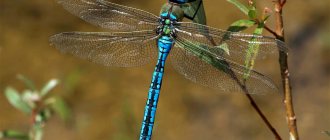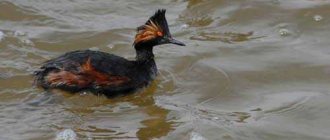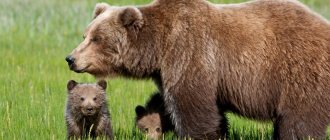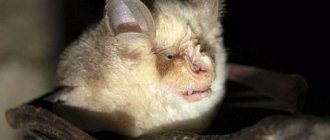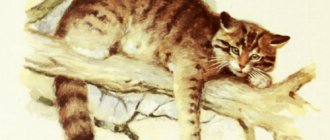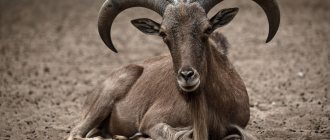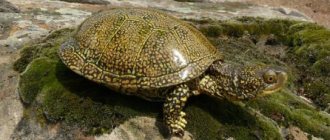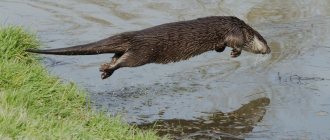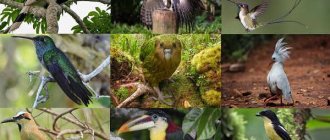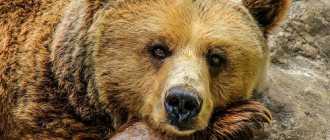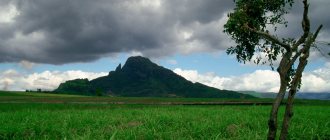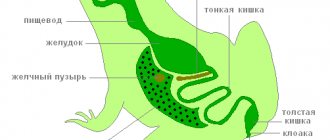Red Book of Animals of Russia - what is it?
Getting acquainted with the animals of the Red Book should begin in childhood. Children of primary school age will understand from a very young age that the destruction of animals should not be allowed. Children should be explained that the animal world should be protected, and that endangered rare species should be treated especially carefully.
This article is a tip for parents, teachers, and older children who want to find out for themselves and tell their children about the Red Book, to get acquainted with rare species of various animals listed in the Red Book. Brief descriptions and photographs of rare animals are presented here.
There are a huge number of animals in the world. But, unfortunately, many of them are at the stage of extinction. Populations of some animal species are gradually disappearing from the face of the globe; many species have already become extinct.
The reason for the decline in animal populations is primarily human activity. Most often, people can unknowingly harm not only animals, but also plants. This occurs as a result of environmental pollution by atmospheric toxic substances, deforestation, during the development of new lands and other anthropogenic actions. But, unfortunately, some people deliberately destroy animals. Such people are called poachers. For the sake of valuable fur, meat, and tusks, poachers destroy animals all over the world. The problem of poaching is very serious in many countries around the world.
The following animals no longer exist in nature:
- Tarpan horse
- Turanian tiger
- Sea cow
- Tour
Now these species can only be found on the pages of encyclopedias. But once they existed in our nature, they were a numerous part of the fauna.
Important: the Red Book was created . The book is called this because the color red symbolizes danger and anxiety. The book exists to draw the attention of all people to the existing problem of extinction of animal and plant species. The Red Book includes not only animals, but also rare species of plants and fungi. Our country also has a Red Book of Animals.
The pages of the Red Book have their own colors, which indicate:
- Black - the animals listed on these pages are already extinct.
- Red - indicates animals on the verge of extinction.
- Yellow - rare species of animals that are not yet extinct.
- Green—restored populations.
- White - species of animals that are in doubt of extinction.
The Red Book of the USSR first appeared in 1978. Since then, the book has been supplemented many times with new names of animals. The Red Book and the animals listed in it are protected by law. The Red Book is a state document.
There are regional books, in them you can see rare animals of a certain region. A lot of work is being done to identify rare and endangered species of animals. Some species are called into question, and the Red Book also makes it possible to preserve the number of rare animals and revive their population. For example, thanks to human protection and care, it was possible to restore such animal species as elk, river beaver, stag beetle, and belladonna.
Actions to protect endangered species
Every year, disappearing populations reduce the planet's biological diversity. Rare species on the verge of extinction should be protected by global communities. Measures taken to protect animals:
- Bans on harvesting certain species.
- Regulation of production taking into account the number of individuals.
- Protection of forests and habitats of rare populations.
- Breeding, restoration.
- Creation of protected reserves.
- Preventive activities.
- Involving volunteers in environmental work.
To protect and protect the wealth of wildlife, each country allocates a presidential grant.
Mammals of the Red Book of Russia: names, photos, descriptions
The list of endangered animal species is very long. We will list the most famous of them.
Amur tiger
One of the largest representatives of the cat family. In size it is second only to the Bengal tiger. The Amur or Ussuri tiger lives in the Russian Far East. The tiger is adapted to survive in cold conditions thanks to a thick layer of fat. Amur tigers live alone. Sometimes females can be found in a group. The weight of the animal can reach 250 kg. This species requires a huge territory in which it will be the owner (0.5-1 km). In the wild, a tiger lives 15 years; in captivity, it lives up to 20 years.
Amur tiger
Polar bear
A large predator that lives near the Bering and Chukchi Seas. The Chukotka range of polar bears is considered the largest in the world. High mortality among young animals is common among polar bears. 10-30% of cubs die, and bears reproduce slowly. This makes the species look vulnerable. The body weight of a male can reach 450 kg, and cubs are born weighing 700 grams. The polar bear is considered a symbol of the Arctic.
Polar bear
Red Wolf
A rare species of canid. The red wolf differs in many ways from its cousins, the gray wolves. It can be confused with a fox; it is distinguished by a reddish tint of its skin and a fluffy tail. Scientists put forward the opinion that it was not man who caused the extinction of this species, but nature. It is believed that gray wolves are to blame for the disappearance of their brothers, with whom red wolves cannot compete in strength.
Red Wolf
Bison
This huge representative of artiodactyls lives on average 23-25 years. Basically, bison live in nurseries. This is how their population is preserved. They are also released into the wild. Bison live in small herds consisting of females and calves. Bulls live alone. The bison, as a rule, does not attack humans and behaves calmly.
Bison
Altai mountain sheep
Lives in the mountainous regions of Altai, Eastern Siberia. Due to the fact that the species lives in hard-to-reach places, it is difficult to track its numbers. Mountain sheep are often attacked by wolves and other predators, which reduces their numbers. It is famous for its luxurious horns, which makes it a tasty prey for hunters.
Altai mountain sheep
Snow Leopard
Another name is snow leopard. A small part of the total number of snow leopards lives in Russia (10-20%). Habitat in Russia - Buryatia, Krasnoyarsk Territory, Altai, Khakassia. The snow leopard is a lithe big cat with a beautiful smoky gray coat and ringed spots. The snow leopard lives in the wild for about 13 years; in captivity, its lifespan increases to 21 years.
Irbis
bottlenose dolphin
Bottlenose dolphins are very friendly dolphins. They do not attack humans; on the contrary, they show interest. There are known cases when schools of bottlenose dolphins surrounded people in a ring, protecting them from sharks. There are also cases of bottlenose dolphins rescuing drowning surfers. These are very smart animals. It has been proven that in captivity they are often exposed to stress, which affects their life expectancy.
Dolphin
Caucasian European mink
It is a subspecies of the European mink. It lives in the Caucasus in small rivers and streams. For a long time, mink were destroyed in order to obtain valuable fur.
Caucasian mink
Birds of the Red Book of Russia: names, photos, description
Important: There are a lot of birds in need of protection. Birds often become prey to predators and die. In addition, birds are dying out due to habitat pollution, deforestation, and drainage of swamps.
Below are several representatives of birds from the numerous list of endangered species. It’s worth knowing them in order to protect them and help you survive.
Red kite
The kite is a bird of prey of the hawk family. This is a medium sized bird. It reaches a length of about 70 cm. Having seen the prey, the kite flies down like a stone and grabs it with its sharp claws. On the territory of Russia it lives within the Kaliningrad and Pskov regions, as well as in the Caucasus. The reason for the extinction of kites is human hunting of these birds. Kites often prey on poultry, which causes people to have a negative attitude towards the species.
Red kite
Black stork
A bird of the Stork family with a characteristic black color. This bird avoids people and hides, so it is difficult to observe the life of a black stork.
Black stork
Mandarin duck
A small wood duck with bright colors. On the territory of Russia, the mandarin duck lives on Sakhalin, the Amur Region, and the Khabarovsk Territory. More often the mandarin duck can be found in nature reserves and zoos. In the wild, the mandarin duck builds nests in hollows near water and lives near bodies of water. She rarely dives, only if she is wounded. Chicks are very sensitive to cold and often die. This bird often becomes prey for raccoon dogs and people, which has greatly affected the population of the species.
Mandarin duck
Steppe and stone eagle
These two species are listed in the Red Book of Russia as endangered species. This large bird of the hawk family builds nests on the ground, in small bushes, and in rocks. Rarely builds a nest in a tree. It feeds on rodents, small birds, and carrion. Eagles, especially young ones, are dying out as a result of electric shock on power lines.
steppe eagle
Owl
A large predator from the owl family. The eagle owl is adapted to life in various areas, but most often settles away from humans. It feeds on mice, hedgehogs, small amphibians and birds. The eagle owl has a unique voice that changes depending on the situation. Eagle owls often die as a result of electric shock on power lines.
Owl
mountain goose
A migratory bird famous for its record high flight. A case of bar-headed geese flying at an altitude of 10 thousand meters was recorded. The bar-headed goose is an endangered species. There are about 1,500 individuals in total in Russia, most of them in Altai and a small part in Tuva.
mountain goose
Ptarmigan
Lives in tundra, taiga, forests. The white partridge changes its color depending on the season. In winter it is white, in summer it is brown. Leads a terrestrial lifestyle and takes off on rare occasions. When a severe winter begins in the habitat of the white partridge, it flies to warmer places.
Ptarmigan
Florida cougar
This is the rarest subspecies of puma. Its population in the wild in 2011 was just over 160 individuals (and in the 1970s it dropped to approximately 20 individuals). The cougar lives in the swampy and forested areas of South Florida, which are located on the territory of the Great National Wildlife Refuge. Its first descriptions appeared immediately after the discovery of America. Americans were amazed by the dexterity, ferocity, and cunning of this cat, and at the same time, its beauty and grace forced them to admire.
The reasons that provoked the extinction of the Florida puma are said to be deterioration of the ecological environment, work to drain swamps, and sport hunting.
The main reason for extinction is the loss of its habitat. The reason is that Florida's forests are disappearing several times faster than, say, the tropical forests of South America. This means that the Florida puma species has little chance of expanding its population. Therefore, people come to the rescue, creating nature reserves and sanctuaries where pumas are strictly controlled.
The weight of an adult reaches up to 27–50 kg. She deftly climbs trees and mountain slopes. It jumps to a height of up to 2.5 m and a length of up to 6 m. Thanks to its strong muscular legs, it can reach speeds of up to 50 km/h, although over short distances.
To maintain life, an adult needs to catch a large animal twice a week, and even more if there are kittens. Although up to 80% of attacks are successful, due to the cat’s agility and quick reaction.
A hungry cougar, whose prey is often deer, does not disdain other small animals: raccoons, rabbits, squirrels and other rodents. There are cases when a cat's territory is adjacent to human populations, and the puma attacks livestock and poultry. Moreover, it kills more than it can consume. She carefully camouflages the carcasses of killed animals and feeds for a long time from her pantry.
Amphibians of the Red Book of Russia: names, photos, description
Amphibians are similar to reptiles and fish. This is a class of primitive vertebrate four-legged animals. The number of amphibians is decreasing due to human pollution of their habitat. Meanwhile, amphibians play an important role in nature. They eat insects that can harm both crops and be carriers of various diseases.
The following species of amphibians are listed in the Red Book of Russia:
Reed toad
It has a color ranging from sand to gray-olive. The body length is about 8 cm. The species can be recognized by the yellowish stripe located along the back. The skin of the reed toad is covered with tubercles. On the territory of Russia, only one habitat is known - the Kaliningrad region. The lifespan of this species is about 15 years. The toad lives in lowlands and loves well-warmed areas by the sun, bordering on humid places.
Reed toad
Caucasian toad
The largest representative of amphibians living in Russia. Body length is about 12.5 cm. The color of small frogs is orange, adult frogs are brown or grayish. The Caucasian toad lives in tree hollows and soil voids. A threat to the population of Caucasian toads is the striped raccoon, which feeds on this species.
Caucasian toad
Ussuri newt
A large tailed newt measuring about 9 cm. Lives in cold streams with a water temperature no higher than 12*C. A necessary condition for the life of the Ussuri newt is the presence of stones or pebbles on the shore, as well as high humidity of the shores. When in danger, the newt buries itself in stones. The Ussuri newt does not have lungs; it breathes through its skin, so it cannot tolerate dry skin.
Ussuri newt
Triton Karelina
Of the genus of newts, Karelin's newt is the largest. Some individuals can reach 18 cm in length. Habitat is the Crimean Peninsula. The skin of the Karelin newt is rough and has a coarse grain. Color: gray, brown with dark spots. The abdomen is yellow or orange. During the mating season, males develop a crest. Males live 8 years, females - 11 years.
Triton Karelina
Common newt
Males and females can only be distinguished during the mating season. The male develops a crest and becomes larger in size than the female. The common newt has a distinctive feature - a longitudinal dark stripe passing through the eyes. In captivity, the common newt can live up to 20 years. In the natural environment, the number of newts is declining due to pollution of water bodies. It is known that in its natural habitat the newt lives no longer than 6 years. Syrian spadefoot. An amphibian similar to a frog, but separated into a separate genus - spadefoot. The Syrian spadefoot has large, bulging eyes with vertical pupils. In Russia it lives in the delta of the Samur River.
Common newt
Caspian seal
At the beginning of the twentieth century, the Caspian seal population was large and numbered one million individuals. A little more than a hundred years have passed, and the number of marine mammals has decreased by 10 times - to 100 thousand. Scientists predict a further decline in the population due to a number of factors: pollution, climate change, habitat destruction and disease. The most pressing problem is the mortality of young animals as a result of hunting. Since hunting a grown-up animal is not an easy task, poachers prefer to hunt a defenseless baby seal (baby seal). According to some reports, shooting reaches 6 - 7 thousand individuals per year. This figure is comparable to the permitted shooting volume. Thus, a population decline is guaranteed even with a low level of hunting. Scientists believe that seal fishing should be banned for several years.
Insects of the Red Book of Russia: names, photos, description
In Russia, insects were not included in the Red Book immediately after the book was published. Only 6 years later, namely in 1984, a list of insects in need of protection was published. After the October Revolution, agriculture actively developed, but insect protection remained stagnant. This led to significant destruction of biotopes.
Currently, the Red Book of Russia includes about 100 species of insects.
These include:
Smooth bronze
A beetle measuring about 3 cm with a beautiful shiny green tint. Sometimes the color is copper-red. It lives on old trees; the larvae appear in the hollows of rotten trees. You can find bronze on overripe fruits on trees.
Smooth bronze
Stag beetle
The beetle got its name due to the peculiar structure of the upper jaws, similar to horns. Lives in deciduous forests. The decline in the population of this species is due to massive deforestation, as well as the destruction of the species by collectors. Often beetles are not destroyed on purpose.
Stag beetle
Krasotel fragrant
A species from the genus of ground beetles. Unlike many ground beetles, the fragrant beetle flies well and moves deftly along the branches and trunk of a tree. This beetle feeds on caterpillars and pupae. In case of danger, it releases a substance with a strong odor. You can recognize this beetle by its color: its head has a blue tint, and its wing covers are blue-green with a golden tint.
Krasotel fragrant
Golubyanka Filipeva
A species of butterfly whose numbers have reached a critically low level. There are about 6 known habitats of Filipiev's blueberry. In Russia it can be found in the south of Primorsky Krai in low bushes along river banks. The color of the upper wings is violet-blue, the lower ones are grayish with black splashes.
Golubyanka Filipeva
Wax bee
A species of social bees with a very small habitat in Russia. Lives in hollows of old trees. The number of wax bees is rapidly declining. There is information that there are about 60 families of wax bees in total. Another name is Chinese wax bee.
Chinese wax bee
Woodcutter
A massive beetle with large mustaches. Dimensions: females can reach a body length of 6 cm, and males 4 cm. The largest representative of the genus of woodcutter beetles is the relict woodcutter. The size of males can reach 10 cm. The color is rich brown. In Russia, such beetles can be found on the Black Sea coast, as well as in the Caucasus.
Woodcutter beetle
Reptiles of the Red Book of Russia: names, photos, description
Among reptiles there are also species that are protected and cannot be destroyed. These types include:
Far Eastern turtle
This type of turtle belongs to the soft-bodied turtles. In Asia, the Far Eastern tortoise is a common sight. The meat of this turtle is known to be eaten. However, on the territory of Russia the species is listed in the Red Book; such a turtle can be found on the territory of our country in small habitats in the south of the Far East.
Far Eastern turtle
Gray gecko
A very small lizard no more than 5 cm. In other countries, the gray gecko is not a rare species. In Russia, the gray gecko is considered to be on the verge of extinction or a completely extinct species. The last location of the gray gecko on the territory of the Chechen Republic. The gray gecko loves to live in dry desert areas, desert or semi-desert areas.
Gray gecko
Medium lizard
The largest of the genus of green lizards. The body length can reach 17 cm, and the tail length - 25 cm. Young lizards are brown in color, and adults are rich green with black spots. On the territory of Russia, the average lizard lives in two places: Dagestan and Krasnodar region.
Medium lizard
Poloz
A snake from the genus Colubrida. Several species of snakes are included in the Red Book of Russia: Transcaucasian, Aesculapian, Japanese, striped, thin-tailed. Some species in Russia can be found extremely rarely. For example, the Japanese snake lives only on the Kuril Islands. The Transcaucasian snake lives in the Caucasus. The number of snakes is declining due to the destruction of nests and the destruction of snakes.
Aesculapian snake
cat snake
The species belongs to the Colubridae family. The snake's pupils are vertical, the head is separated from the body by an interception. Color: gray, maybe pinkish. Body flattened laterally. Lives in the territory of Dagestan. Loves slopes with sparse vegetation. Good at climbing trees and walls. In the hot season, the activity of the cat snake begins at night.
cat snake
Gyurza
One of the most dangerous snakes for humans and animals. The viper is the largest representative of the viper family. Its length can reach 2 m. Moreover, in a dangerous situation, the viper can make lunges equal to the length of its body. Even experienced snake catchers fell prey to the viper. The snake can live in various biotopes, but is most often found near springs, rivers and reservoirs.
Gyurza
Caucasian viper
The venom of the Caucasian viper is deadly to humans. The snake is characterized by a bright color, often black, as well as red and orange. Juveniles are brown. Males are smaller in size than females. The snake lives in deciduous forests, lives in vineyards and gardens.
Caucasian viper
Squeaky gecko
This is a very small lizard measuring no more than 4 cm. The color of the gecko is pale yellow with a grayish coating. The belly is white with lemon. In Russia, you can often find the squeaky gecko in the vastness of the Astrakhan region. Lives in desert areas.
Squeaky gecko
The rarest animals of the Red Book of the World: list, names, description
Important: The problem of declining animal numbers is observed all over the world. Despite hunting bans and special attention to certain species of animals, the numbers of some species continue to approach zero. Below is a list of the rarest animals in the world that risk ending up in the near future only on the pages of encyclopedias and photographs.
The rarest animals in the world:
- Florida cougar . At last count, there are 230 individuals of this species in the natural environment. The Florida cougar lives in southern Florida in a nature reserve. The only enemy of the Florida cougar is the large alligator. Several factors led to the extinction of the species: scarce genetic material, which resulted in crossing with closely related animals, sport hunting and drainage of the swamps in which this animal likes to live.
- Hirola . This is a rare species of antelope in Africa. The number of hirolas is negligible; there are doubts about whether hirolas still exist, or whether the species is completely extinct. Hirols have long uneven horns, a long face, and a long body. They feed on grass vegetation. When the grass runs out, they migrate to another place. They go without water for a long time due to decreased activity. They are most active in the morning and evening.
- Sumatran rhinoceros . The smallest representative of rhinoceroses. There are several populations; keeping records of Sumatran rhinoceroses and monitoring their lives is difficult due to the animal’s solitary lifestyle. The Sumatran rhinoceros leads a solitary lifestyle, with the exception of the period of birth and nursing the baby. The habits and lifestyle of the animal have not been sufficiently studied, which makes it difficult to keep this species in captivity.
The list of animals is quite long. But this is only a small part of the animals that are on the verge of extinction. Some animals disappear due to natural disasters, but most of them are due to human cruelty and too active human activity. Animals are our little brothers, we must take care of them.
Irbis or snow leopard
The snow leopard is a rare, small and endangered species. Despite the fact that the snow leopard is at the top of the food pyramid and does not experience competition from other predators, its numbers are continuously declining due to constant persecution by humans. The snow leopard inhabits the high mountains of Central and Central Asia.
Irbis
